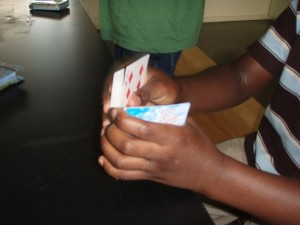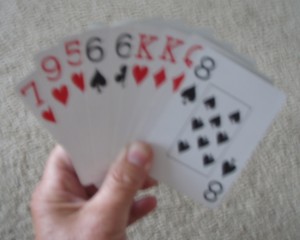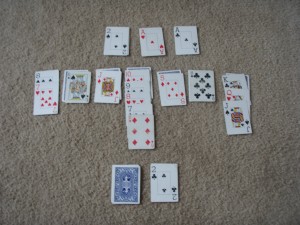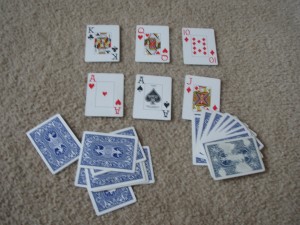Back in prehistoric times (that is before electronic devices…) I spent large swaths of my summer vacation figuring out how to spend my time. When I had early morning trips to the park and the purchase power to buy “GIMP,” I’d spend the afternoon covering wire hangers decoratively with the plastic laces or making perfectly useless lanyers or key chains (How many did you really need?).
Once I’d completed these projects or hadn’t made the trip, I had time on my hands…So, that’s when I’d pull out a deck of card. Sometimes my older sister would honor me with a few minutes to play a card game or two (Rummy, Gin, Crazy Eights or SPIT). But mostly, I was alone and I played Solitaire…for hours.
Playing cards are a backdoor way into building fine motor control, finger dexterity, visual perception and motor planning. For me it was a cure for boredom. For your children, it’s a chance to sneak in some skill building without their awareness!
Playing Cards are low cost, simple and provide hours of entertainment. Activities are reviewed, appropriate for each age and developmental level.
First, know that you should go to an inexpensive store and buy the cheapest deck you can find. Kids are not kind to cards, They will bend, tear and undoubtedly lose many of them in a matter of hours (am I being too generous here?). You can buy decks in bulk at some discount warehouse type stores. I recommend this strategy.
Infants and babies:
- Displaying cards while the baby spends time on the tummy makes an interesting visual change from a mobile. Remember that very young infants see black and white best so those spades and clubs provide nice designs for the baby to look at.
- You can also hold a card up in front of the baby while sitting in a supported chair and move the card slightly right and left, up and down, to encourage visual tracking.
Older babies and toddlers:
- Grasping and Retrieving cards scattered around the floor gets the baby rolling, scooting and crawling.
- For the early walker, it is an opportunity to practice bending down many times. This strengthens the legs and challenges balance.
- Those chubby hands also have to struggle to grasp the cards. Be prepared for mangled cards. Use the deck that your older preschooler already ruined for this age group.
- To stimulate interaction, pretend play and more fine motor control, you can play Give and Take with your young one. Simply handing the cards back and forth can be great fun for a little, little one.
Caution: Babies and toddlers are likely to put the cards in their mouths. I do not recommend allowing this. While it may provide oral stimulation that is very organizing, the ink likely comes from China and we know how that goes…
Preschoolers:
- Real games can begin. The best is Memory or Concentration. Begin with only a few cards; picture cards with clear distinctions should be selected first. For example, one red queen pair and one black king pair. Jacks look too much like Kings so shouldn’t be paired together until the child does a good job identifying this subtle distinction.
- Place the cards on a carpet and sit on the floor. This allows the child to use finger tips to pick up the cards. When the cards are on a table, the child will slide them off to get at them. On the carpet, the child is required to use the fingers tips. Many important muscles in the hand are used and consequently get stronger. Many of these same muscles will be used to hold a pencil later on.
- Simple preschool card games can also be played. Go Fish and Old Maid are examples. There are ways to play these with regular playing cards.* You do not need to run out to a toy store to buy the $10 gift set of Old Maid and Go Fish.
- My favorite for this age group is Slap Jack. It requires visual attention and motor planning to recognize the Jack quickly and organize a rapid response to slap the card pile before the opponent.
- At this age you can start to teach the child how to make a neat pile of the cards and hold fanned cards. But don’t expect perfection. The muscles required to do this are just developing. The younger preschooler will likely still be very sloppy. Some semblance of order should occur with an older preschooler after they have practiced for a while. As they practice, guess what? Strength develops in those little hands and fingers.
Kindergarten and Early Elementary:
- The child should be able to make a fan fairly well and hold onto it while taking cards in and out of the fan. Once again, the younger child will drop cards and may resort to a pile until the hand muscles get stronger. Practice, patience and practice!!!
- Games can incorporate academic skills the child is learning such as numerical weighting, categorization, matching, and sequencing. War is a favorite. The adult may want to split a wrist on the eleventh round of this game, but children truly love it. Making simple comparisons of the “higher” number and picture card is an ongoing delight. Remembering the sequence of how many cards to lay down when there is a “battle” and the suspense of winning or losing many cards is a big thrill.
- As the child progresses with card games, more complex reasoning and visual memory skills are called for. Rummy type games require some recall of previous cards played, some strategy and ongoing visual scanning of cards layed down. Games like Crazy Eights, likewise use some of the visual perceptual skills but also challenges fine motor control when holding half the deck.
Older Kids:
- There are many forms of Solitaire. Kids play this on the computer. Why don’t you suggest trying it with good old fashioned cards. Spreading the cards on the floor (or course!) requires a broader range of visual scanning. Sequencing and strategy really come into play with these games. There are many complicated games for two or more to play together. I remember playing Spit for hours. These card games are perfect for the pre-teens who are crawling out of their skin and boredom is a constant battle.
- For the intellectually advanced child, teach Bridge and other more strategy intensive games. Like Chess, these games will activate more complex thinking.
- The shuffling and dealing of cards will continue to refine fine motor dexterity. Shuffling is another nice challenge for the child 7 or 8 years old and up. This requires the development of the intrinsic muscles in the hands and fingers. Well developed intrinsic muscles are a big factor in whether children have sloppy or neat handwriting and strong manipulative skills.
- Remember, older children still enjoy playing card games outlined for the younger child. Playing a simple card game allows for fun without the added demand of a cognitive challenge. Allowing the brain to relax can give the neurological structures the opportunity to organize. So, your nine year old might dazzle you with how quickly he is learning to play Bridge. But this very same nine year old will likely enjoy playing Crazy Eights with you and maybe even take over a round or two of War with a younger sibling.
Listing of an unbelievable number of card games, instructions included: http://www.pagat.com/alpha.html
Specific instructions for using a regular deck of cards for Old Maid and Go Fish and a few others: http://www.ehow.com/way_5415464_fun-easy-card-games.html
List and instruction for Solitaire Games: http://en.wikipedia.org/wiki/List_of_solitaire_card_games
Teaching Bridge to kids: http://www.kittycooper.com/Bridge/modules.php?name=For_Teachers
More on Bridge: http://www.abf.com.au/youth/learning/child_bridge.html



